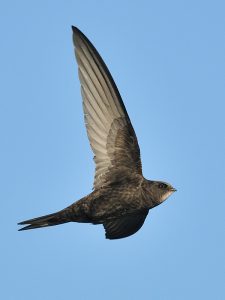The high and lows of South Downs swifts
January 11, 2024
Swifts have declined across the UK by more than 50 per cent over the past two decades. Tim Norriss, a Trustee for the charity Hampshire Swifts, writes about the highs and lows of this charismatic species and the volunteers’ valiant efforts to help populations bounce back.
 The highest-nesting swifts are in the tower of Winchester Cathedral – a dizzying 150 feet – while the lowest are in the eaves of a single-storey porch of a small church at Idsworth, near Horndean.
The highest-nesting swifts are in the tower of Winchester Cathedral – a dizzying 150 feet – while the lowest are in the eaves of a single-storey porch of a small church at Idsworth, near Horndean.
Another high, albeit metaphorically, is the growing success of the swift box installation scheme, run by Hampshire Swifts.
But there is a low causing concern for our charity – the lack of national legislation to compel developers to include swift bricks at a ratio of at least one per dwelling. These specially-designed bricks have been developed with the help of conservation experts and provide a safe and spacious area for swifts to nest in .
Although swift nests are, extremely rarely, found nesting in cliffs and trees, they are actually more often found in structures built by humans.
The towns on the western boundary of the National Park are important for swift populations. In Winchester a new colony was started by the installation of boxes in the cathedral’s tower and, as a result, nine nesting pairs were recorded last year. An incredible win for nature.
Meanwhile, a declining population in St Cross Hospital, an ancient alms house, has been revitalised by installing new boxes within the eaves and removing old wire blocking access. In Alton, a thriving colony of swifts now exists below the shingles of the steeple of St Lawrence’s Church. Our charity was able to successfully intervene when the colony was threatened by scaffolding and netting during the breeding season.
In all three locations, residents have a growing interest in the birds and the installation of the boxes has been warmly welcomed.
I can’t write a column about swifts and the National Park without mentioning Selborne – not only for the stunning weathervane featuring swifts on the village hall but also because of the attention that the famous naturalist Gilbert White paid to swifts, with his journals recording great details of their fascinating lives.
This is such a beautiful bird species that needs everyone’s help to recover – did you know they are the fastest birds in level flight, with an impressive top speed of 69mph!
To find out more about the charity and ways you can help swifts, or to report swift activity in your area visit www.hampshireswifts.co.uk
